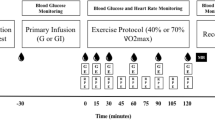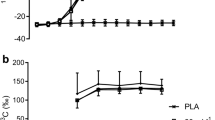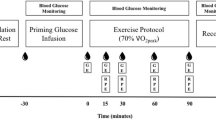Abstract
To determine the limits to oxidation of exogenous glucose by skeletal muscle, the effects of euglycaemia (plasma glucose 5 mM, ET) and hyperglycaemia (plasma glucose 10 mM, HT) on fuel substrate kinetics were evaluated in 12 trained subjects cycling at 70% of maximal oxygen uptake (VO2, max) for 2 h. During exercise, subjects ingested water labelled with traces of U-14C-glucose so that the rates of plasma glucose oxidation (R ox) could be determined from plasma 14C-glucose and expired 14CO2 radioactivities, and respiratory gas exchange. Simultaneously, 2-3H-glucose was infused at a constant rate to estimate rates of endogenous glucose turnover (R a), while unlabelled glucose (25% dextrose) was infused to maintain plasma glucose concentration at either 5 or 10 mM. During ET, endogenous liver glucose R a (total R a minus the rate of infusion) declined from 22.4±4.9 to 6.5±1.4 μmol/min per kg fat-free mass [FFM] (P<0.05) and during HT it was completely suppressed. In contrast, R ox increased to 152±21 and 61±10 μmol/min per kg FFM at the end of HT and ET respectively (P<0.05). HT (i. e., plasma glucose 10 mM) and hyperinsulinaemia (24.5±0.9 μU/ml) also increased total carbohydrate oxidation from 203±7 (ET) to 310±3 μmol/min per kg FFM (P<0.0001) and suppressed fat oxidation from 51±3 (ET) to 18±2 μmol/min per kg FFM (P<0.0001). As the rates of oxidation at more physiological euglycaemic concentrations of glucose were limited to 92±9 μmol/ min per kg FFM, and were similar to those reported when carbohydrate is ingested, the results of the current study suggest that the concentrations of glucose and insulin normally present during prolonged, intense exercise may limit the rate of muscle glucose uptake and oxidation.
Similar content being viewed by others
References
Abbott WO, Karr WG, Glenn PM, Warren R (1940) Intubation studies of the human small intestine. XIV. The absorption of glucose from the duodenum. Am J Med Sci 200:532–536
Allsop JR, Wolfe RR, Burke JF (1978) The reliability of rates of glucose appearance in vivo calculated from constant tracer infusions. Biochem J 172:407–416
Argoud GM, Schade DS, Eaton RP (1987) Underestimation of hepatic glucose production by radioactive and stable tracers. Am J Physiol 252:E06-E615
Bergman RN, Bier JR, Hourigan PM (1982) Intraportal glucose infusion matched to oral glucose absorption: lack of evidence for “gut factor” involvement in hepatic glucose storage. Diabetes 31:27–35
Bosch AN, Dennis SC, Noakes TD (1993) Influence of carbohydrate-loading on fuel substrate turnover and oxidation during prolonged exercise. J Appl Physiol 74:1921–1927
Broberg S, Sahlin K (1989) Adenine nucleotide degradation in human skeletal muscle during prolonged exercise. J Appl Physiol 67:116–122
Coggan AR (1991) Plasma glucose metabolism during exercise in humans. Sports Med 11:102–124
Consolazio CR, Johnson RE, Pecora LT (1963) Estimation of respiratory gases. In: Physiological measurements of metabolic functions in man. McGraw-Hill, New York, pp 72–87
Coyle EF, Coggan AR, Hemmert MK, Ivy JL (1986) Muscle glycogen utilization during prolonged strenuous exercise when fed carbohydrate. J Appl Physiol 61:165–172
Coyle EF, Hamilton MT, Alonso JG, Montain SJ, Ivy JL (1991) Carbohydrate metabolism during intense exercise when hyperglycaemic. J Appl Physiol 70:834–840
DeFronzo R, Ferrannini E, Hendler R, Wahren J, Felig P (1978) Influence of hyperinsulinemia, hyperglycaemia, and the route of glucose administration on sphlanchnic glucose exchange. Proc Natl Acad Sci USA 75:5173–5177
DeFronzo RA, Tobin JD, Andrea R (1979) Glucose clamp technique: a method of quantifying insulin secretion and resistance. Am J Physiol 237:E214-E223
Durnin JVG, Wormersley J (1974) Body fat assessed from the total body density and its estimation from skinfold thickness: measurements on 481 men and women aged from 16 to 72 years. Br J Nutr 32:77–97
Felig P, Wahren J (1979) Role of insulin and glucagon in the regulation of hepatic glucose production during exercise. Diabetes 28 (Suppl 1):71–75
Finegood DT, Bergman RN, Vranic M (1987) Estimation of endogenous glucose production during hyperinsulinemic-euglycemic glucose clamps. Diabetes 36:914–924
Goetz FC, Greenberg BZ (1961) A simple immunoassay for small amounts of insulin. J Clin Lab Med 58:819–822
Hawley JA, Noakes TD (1992) Peak sustained power output predicts maximal oxygen uptake and performance time in trained cyclists. Eur J Appl Physiol 65:79–83
Hawley JA, Dennis SC, Noakes TD (1992) Oxidation of carbohydrate ingested during prolonged endurance exercise. Sports Med 14:27–42
Hawley JA, Dennis SC, Nowitz A, Brouns F, Noakes TD (1992) Exogenous carbohydrate oxidation from maltose and glucose ingested during prolonged exercise. Eur J Appl Physiol 64:523–527
Issekutz B (1981) Effects of glucose infusion on hepatic and muscle glycogenolysis in exercising dogs. Am J Physiol 240:E451-E457
Jenkins AB, Chisolm DJ, James DE, Ho KY, Kraegen EW (1985) Exercise-induced hepatic glucose output is precisely sensitive to the rate of systemic glucose supply. Metabolism 34:431–436
Moodley DG, Noakes TD, Bosch AN, Hawley JA, Schall R, Dennis SC (1992) Exogenous carbohydrate oxidation during prolonged exercise: the effect of carbohydrate type and its concentration. Eur J Appl Physiol 64:328–334
Radziuk J, Norwich KH, Vranic M (1978) Experimental validation of measurements of glucose turnover in non-steady state. Am J Physiol 234:E84-E93
Rehrer NJ, Wagenmakers AJM, Beckers EJ, Halliday D, Leiper JB, Brouns F, Maughan RJ, Westerterp K, Saris WHM (1992) Gastric emptying, absorption, and carbohydrate oxidation during prolonged exercise. J Appl Physiol 72:468–475
Rennie MJ, Holloszy JO (1977) Inhibition of glucose uptake and glycogenolysis by availability of oleate in well-oxygenated perfused skeletal muscle. Biochem J 168:161–170
Rizza R, Cryer PE, Haymond MW, Gerich JE (1980) Adrenergic mechanisms for the effects of epinephrine on glucose production and clearance in man. J Clin Invest 65:682–689
Rizza R, Mandarino LJ, Gerich JE (1982) Cortisol-induced insulin resistance in man: impaired suppression of glucose production and stimulation of glucose utilization due to a postreceptor defect in insulin action. Clin Endocrinol Metab 54:131–138
Scherrer S, Haldimann B, Kuprer A, Reubi F, Bircher J (1978) Hepatic metabolism of aminopyrine in patents with chronic renal failure. Clin Sci Mol Med 54:133–140
Steele R (1959) Influence of glucose loading and of injected insulin on hepatic glucose output. Ann NY Acad Sci 82:420–430
Stein TP, Hoyt RW, O'Toole M, Leskiw MH, Schluter MD, Wolfe RR, Hiller WDB (1989) Protein and energy metabolism during prolonged exercise in trained athletes. Int J Sports Med 10:311–316
Vissing J, Sonne B, Galbo H (1988) Regulation of hepatic glucose production in running rats studies by glucose infusion. J Appl Physiol 65:2552–2557
Weber JM, Klein S, Wolfe RR (1990) Role of glucose cycle in control of net glucose flux in exercising humans. J Appl Physiol 68:1815–1819
Wolfe RR (1984) Tracers in metabolic research: radioisotopes and stable isotopes/mass spectrometry methods. Liss, New York, pp 67–89
Author information
Authors and Affiliations
Rights and permissions
About this article
Cite this article
Hawley, J.A., Bosch, A.N., Weltan, S.M. et al. Glucose kinetics during prolonged exercise in euglycaemic and hyperglycaemic subjects. Pflugers Arch. 426, 378–386 (1994). https://doi.org/10.1007/BF00388300
Received:
Revised:
Accepted:
Issue Date:
DOI: https://doi.org/10.1007/BF00388300




